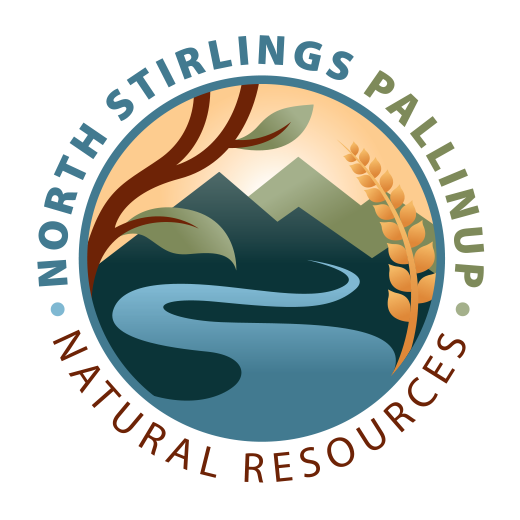North Stirlings - Pallinup Sub-region
The North Stirlings - Pallinup sub-region is located at the western end of the South Coast Natural Resource Management region of Western Australia and is north of the Stirling Ranges . The sub-region covers a total area of more than 541,629 hectares within the local government areas of the Shire of Gnowangerup and Shire of Broomehill-Tambellup. The Borden townsite in the approximate centre of the sub-region is located 379 kilometres (km) from Perth and 121 km from Albany.
The sub-region takes in the Upper Pallinup Catchment and North Stirling Basin. The Pallinup River is the major waterway, draining in a south-easterly direction to the coast at Beaufort Inlet where the river meets the sea.
NSPNR Operational Area
North Stirlings Pallinup Natural Resources Inc (NSPNR) supports landholders in the sub-region. NSPNR’s operational area (see map) is aligned on the north and east with that of the Shire of Gnowangerup and the southern side bounded by the Stirling Range National Park. The western side of the operational area is bounded by the Broomehill East locality (Shire of Broomehill-Tambellup) and the Shire of Gnowangerup boundary.
NSPNR operates within the upper catchment of the Pallinup River, encompassing all major tributaries (Jackitup Creek, Warperup Creek, Peenebup Creek, Six Mile Creek and Salt Creek).
The Pallinup River and Upper Catchment
Three quarters of the Beaufort Inlet catchment is in the North-Stirlings Pallinup sub-region, where >85% of the remnant vegetation is cleared. The river is one of the largest river systems on the South Coast, spanning roughly 250km long. Wetlands are also an integral part of this catchment system, encompassing large areas of internal drainage in the south-west corner known as the Balicup Wetland Suite or Lake System (see details below). This suite is thought to be an ancient channel into the Pallinup River.
Wetland Systems (Balicup Wetland Suite)
North Stirlings Pallinup Natural Resource works closely with The Gillamii Centre to deliver landcare works across the Balicup Lake System which spans the two sub-regions. The salt lakes of the North Stirlings including the Balicup Lake System are thought to be ancient drainage from the Gordon River. The lakes lie between the Pallinup drainage basin and the upper Gordon catchment and then extend south to the Stirling Ranges. Most lakes drain into the Pallinup River, however in unusually wet years the lakes are known to drain to the Gorden River.
The Balicup Lake System is one of the wetlands systems that is listed under the National Directory of Important Wetlands in Australia and consists of several wetlands, such as Lake Balicup, Camel, and Jebarjup (Tom South, Munrillup, Horse Shoe, Anderson and Cheepanup), occurring in small nature reserves or on private land. They are important partly because of range of species of waterbirds that they support, including some like the Banded Stilt that are protected under international treaties.
Aboriginal Settlement
The Pallinup River traditionally supported important campgrounds, travel routes, food sources and drinking water for the Mineng and Goreng people. The Stirling Ranges have a high cultural significance, featuring in many of their stories.
Natural Assets of the North Stirlings - Pallinup Sub-region
The major land use in the North Stirlings - Pallinup sub-region is agriculture, producing winter crops and sheep grazing. It is dominated by a Mediterranean-type climate with winter dominant rainfall (average annual rainfall 387.5 millimetres, BOM) with summer storms. Landholders have been supported to protect areas of remnant vegetation, and the riparian zones of the Pallinup River and tributaries are gradually being fenced to exclude stock. It is estimated that, outside of nature reserves, there is less than 15% of the original pre-European vegetation remaining in the Upper Pallunup Area.
The Stirling Range National Park is recognised as a biodiversity hotspot containing over 1,500 species of plants. Camel Lake and Corackerup are also significant nature reserves located in the sub-region.
Soils
The soils range from deep sandy duplex to shallow sandy duplex soils. Soil salinity, water logging, subsurface compaction, subsurface soil acidity, wind erosion , water erosion and water repellence challenge plant growth in the sub-region.
Vegetation
The native vegetation in the northern part of the sub-region is Mallee heath and Eucalypt woodland with some swamp sheoak along the rivers. In the south, Mallee heath and Jarrah-Marri or Wandoo woodlands dominate the remnant vegetation.
21 species of declared rare flora and 12 species of priority flora may be found in remnant vegetation in the sub-region.
Perennial pastures are an alternative to annual pastures and crops, which maintain groundcover and improve soil structure and stability. Perennials that are adapted to saline soil can be effective in increasing plant growth on salt-affected area.
Animals
Feral animals including foxes and rabbits are a threat to soil resources and native animals in the sub-region.
Native animals of particular interest include the Australasian bittern, chuditch (western quoll), malleefowl, and red-tailed phascogale. Also Carnaby's cockatoos and black-gloved wallabies.
Natural Resource Management Issues
Feral animals, soil health issues, Phytophthora dieback and human disturbance are major threatening processes in the sub-region. Phytophthora dieback particularly threatens the Stirling Range National Park.
The regional group, South Coast Natural Resource Management Inc, provides support and information about natural resource management issues to sub-regional organisations such as North Stirlings Pallinup Natural Resources. Other NRM organisations in the South Coast region include Fitzgerald Biosphere Group Inc, Gillamii Centre, Oyster Harbour Catchment Group Inc, Ravensthorpe Agricultural Initiative Network Inc, Torbay Catchment Group and Wilson Inlet Catchment Committee Inc.
References:
South Coast NRM 2011 Southern Prospects 2011-2016 - the South Coast Regional Strategy for Natural Resource Management, South Coast NRM, Albany
Water and Rivers Commission 2003 The State of the Pallinup River and the Beaufort Inlet, Natural Heritage Trust
Department of Environment and Conservation 2009 The Resource Condition Report for a Significant Western Australian Wetland Balicup Lake ,


